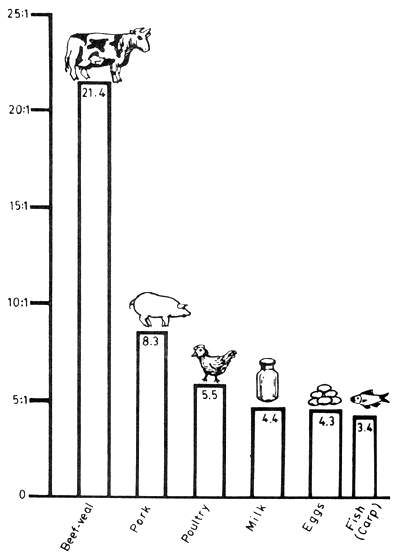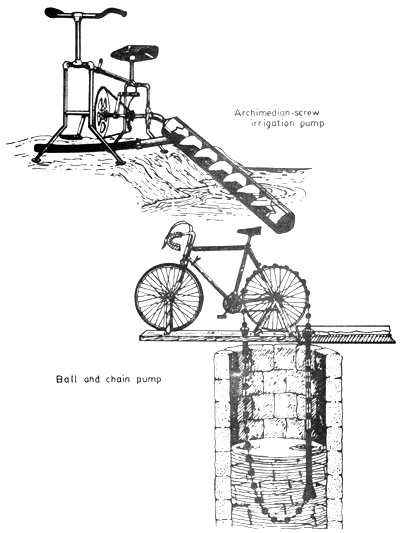The coastal areas of the Indo-Pacific contain thousands of hectares of brackish water fish ponds for rearing milkfish and shrimp. Inland there are thousands of freshwater fish ponds devoted to the culture of carp, tilapia and Macrobrachium prawns. Other species produced include small cyprinids, gourami and clarius varieties. In coastal marine waters, mussel and oyster culture, and seaweed farming, are growing industries. In the ASEAN countries alone, over half a million hectares are used in fish farming, to produce over 380,000 tons of fish a year. Potential sites of further expansion of fish farming measure over 15 million hectares1. Aquaculture holds great promise for future protein supplies as fish are less costly to raise than chicken or pigs, and require one sixth the feeding for every kilogram of protein produced than domestic cattle.
Figure 24

Pounds of protein given to various livestock to produce 1 pound of protein for human consumption. D. Mendola adapted from figure of Lappe and data of Bardach et al.
1 Rabanal, H.R. Technical Report ASEAN 77/FA EgA/Rpt. 2, 1977.
The fish farming industry has probably a more complex socio-economic structure than the fish catching industry. Fishermen may be grouped into owner-operators, vessel and gear renters and employees of vessel owners or operators. Fish farmers include such diverse groups as fry gatherers, fry dealers, pond owners, pond managers, share croppers, pond renters, and employees of pond owners. For the freshwater farms there are also hatchery owners and operators. Much of the benefit of better technology for small scale fish farming will not benefit many in the industry until land ownership reforms or equitable share-cropping arrangements have been introduced. But that subject is beyond the scope of this paper.
While Government and University research departments have greatly expanded the science of fish culture, and thousands of students in the region now study the subject at graduate and post-graduate level, for most fish farmers, raising fish is as basic and as arduous an activity as growing rice. Mangroves must be cleared, ponds must be dug, dykes built, ditches excavated, and sluices constructed before any fish farming can begin. And then ponds must be fertilized, water supply maintained, predators excluded, fish fed, and ponds guarded, before any harvesting and marketing can take place.
We can help the small scale fish farmer at little cost by providing him with simple tools and techniques to make his work easier and more productive. In many cases we can help him improve efficiency by tapping natural energy sources for water pumping and aeration.
The efficiency and production of most brackishwater ponds could be improved if an adequate water supply were maintained. During times of drought and low tides ponds the daily water supply may be reduced or stopped altogether. It may not be economical to run a petrol or diesel pump every day, even if the farmer is able to buy one. But water may be pumped a short distance in modest amounts using wind power.
Windmill driven pumps of many types are now available. Some have worked satisfactorily for many years in rural situations. In Thailand a simple wooden blade windmill drives a dragon wheel pump to provide water for irrigation or fish farming1. In Ethiopia sail rotor windmills worked well driving single and double action pumps to lift from 1,000– 4,000 liters per hour to a 3-meter head, in winds of 5–15 mph2. A sailwing model driving a car type diaphragm pump first tested in India was later improved to provide nearly 1,000 liters per hour in only 6 mph winds3. Savonius rotor driven pumps have been well tested in Canada, Africa and elsewhere. They are not quite as efficient as other types but then they are simpler and cheaper to construct and do not need to be oriented towards the direction of the wind. For those who would rather purchase a complete windmill and pump there are relatively inexpensive models available from manufacturers in Europe and America.
2 Fraenkel, P. Food from Windmills. London, Int. Tech. Publ., 1975.
Figure 25
BAMBOO PIPING AND PLUMBING

Table 7

ref. Village Technology Handbook VITA
While it is technically possible to pump water using solar heat power, as yet the equipment to do this is rather expensive, so wind or water power would be more appropriate. In the near future however, it may be possible to have solar water pumps at a competitive price. Several French firms offer complete units. Those under 20 KW are photo-voltaic systems. Larger units are thermo-dynamic using solar heat energy.
Another way of pumping water involves using the power from a falling stream. This is more applicable to inland fresh water fish farms in hilly or mountain areas. Two units deserve mention. The Blake hydraulic ram can work on a fall of just 1 meter. Given good flow it can pump water to heights of over 100 meters. A recent New Zealand invention, the Plata pump is a simpler turbine that can operate on a fall of only 23 centimeters. Depending on the volume and flow rate of the stream and the actual fall at the turbine, water can be pumped to heights of 10 to 50 meters in quantities of 200 to 1,800 liters per hour. The 3-meter long turbine drives two 19 mm or 38 mm pumps1.
In localities with an abundance of labour it is possible to use some of the novel foot pumps and pedal pumps which can be put together by local blacksmiths or mechanics. These might be used to supplement a minimal tidal supply rather than for permanent pumping2. (See figure 26).
Aeration of fish ponds may be accomplished by windmill power. The windmill drives a simple air pump instead of a generator or water pump and the air pipes are led to the bottom of the pond much as with a simple aerator for aquaria use.
The laborious work of pond construction could be eased with the use of helpful tools and techniques in all cases where power vehicles or machinery are too expensive or unavailable. Some simple but extremely useful tools are illustrated in Figures 27 and 28.
The removal of trees and roots from fish pond beds is a difficult process even with heavy machinery. Power winches are used a lot now to pull the tree trunk over and out of the soil. But hand winches might be equally effective if the operators incorporate 2 double fall blocks between the tree and the winch. This requires a longer rope but it effectively multiplies the power by 4 or 5. The blocks and rope and hand winch cost only a fraction of the cost of the power winch and of course, no fuel is needed.
1 A Self Powered Pumping System. Dunedin, New Zealand, Plata Power, Ltd., 1976.
2 McCullagh, J. Pedal Power. Rodale Press, U.S.A., 1977.
Figure 26

ref. McCullagh, J. Pedal Power, Rodale Press, 1977
Cage culture of fin fish is a growing small scale industry in S.E. Asia. It can be practiced both in the sea and in fresh water rivers. Like many other recent advances in artisanal fisheries it is actually an upgrading of an ancient and traditional practice. The cages can be large or small and apart from the synthetic netting, they are constructed entirely of locally produced materials1.
Mariculture or sea farming can be conducted along very inexpensive lines. Perhaps this offers a unique farming possibility to coastal communities which do not possess much agricultural land. Mussels and oysters can be grown easily on ropes or netting suspended from floating rafts, or on bamboo frames attached to a permanent fish shelter. These units can be built completely by local labour using locally available material1. Cage culture or marine fish can also be conducted from floating rafts in estuaries and bays In some cases it has even been possible to release caged fish and have them return for feeding2. Because of the problems of security, maintenance, and ownership, sea farming might best be conducted communally or cooperatively by an entire village rather than by individuals.
Figure 29

A 100'×30' aquasolarium solar-wind powered aquatic food production unit after a design of D.Mendola and S.Sertling of the Solar Aquafarms, Encinitas, California.
2 Iversen, E. Farming the Edge of the Sea, Fishing News Books, U.K. 1976.